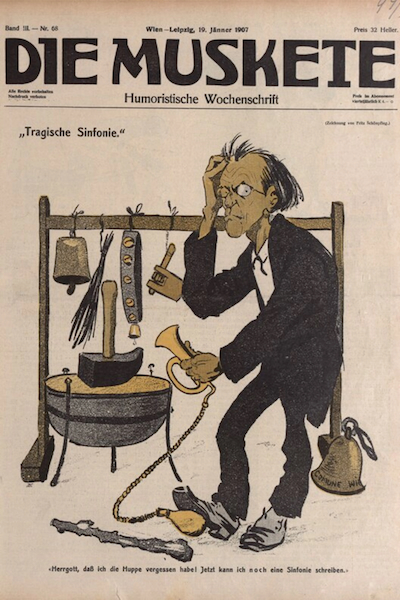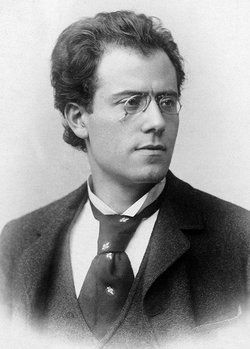The Brief Confessions of a Former Mahler Unbeliever
Or, “My Road to Mahler”
I must admit that when I was a teenager (which lasted until I was 20), I could be a bit difficult. At times, snotty. And at other times, snooty.
One good example is that I used to claim, starting at about the age of 12 or 13, that my goal in life was to earn a PhD degree in History. Further, I would claim that I already had my dissertation topic picked out:
The Position of Women
Under Henry VIII
I sang in school choruses, and I studied the violin. I was passionate about music, but I must admit that my horizons were somewhat limited. Indeed, if there had been such a thing back then as a Card-Carrying Young Baroque Fascist, I would have been one. I never actually said, “You play Bach your way; I’ll play Bach his way.” But I had strong opinions. Opinions that were sometimes based on inadequate study or reflection.
In college, I loved the violin repertory and string quartets, and orchestral music such as the Tallis Fantasia and “The Walk to the Paradise Garden.” But my favorite symphony was Roy Harris's Third, which is compact and concise. Roy Harris's Third Symphony gets it all done, in well under half an hour.
I vividly recall my reaction when I accompanied a female college classmate back to her room, perhaps because she had forgotten something. Her relatively new dorm building had rooms with built-in closets, dressers, and overhead cabinets, with a large mirror recessed on the wall behind the top of the dresser, leaving the dresser top as shelf space for toiletries and such.
I noticed that she had the typical fold-down College Dorm-Room Record Player. OK. Records; then, she must have records. Where are her records, so I can read the spines? Hmmm. Ah! The records are the only thing occupying the top of the dresser, in front of the mirror. Hmm. It’s a hefty boxed set. Positioned almost as though the boxed set was a tabernacle in an alcove. I walked over and read, “Leonard Bernstein, Complete Mahler Symphonies.”
Oh dear. “Sweetie (I thought, but of course I did not say), I sure hope that they invent Prozac before it’s too late!”
Of course, the bit about Prozac is an after-the-fact, retrospective, totally anachronistic fabrication. But the reality was that my opinion of the symphonies of Mahler was (from my perspective of today) shamefully low. I seriously had had the instantaneous reaction that exclusively listening to Mahler might be a sign of, to say the least, serious emotional vulnerability.
Back then, I thought that Mahler symphonies were where kitchen sinks went home to die. If that needs explaining, Mahler was famous for creative orchestration, such as using a bundle of sticks as a percussion instrument. Or, the sledgehammer in his Sixth Symphony. There’s a famous contemporary cartoon of Mahler with a squeeze-bulb car horn that he supposedly will use in his next symphony.
 Caption Translation: “My God, I forgot (about) the car horn! Now I can write another symphony.”
Caption Translation: “My God, I forgot (about) the car horn! Now I can write another symphony.”
Also, Mahler’s orchestral works did run long. My juvenile (or, sophomoric) attitude was that music rarely had good reason to run longer than Bach’s D-minor violin Partita, or the Goldberg Variations.
Also, in contrast to Bach’s often geometrical perfection, Mahler’s “pushing the envelope” in symphonic form struck me, at times, as formless. Little did I know back then that Alexander Courage’s Star Trek OTS (Original Television Series) theme music had been inspired in part by Mahler’s First and Seventh Symphonies.
But perhaps my reaction to the Bernstein Mahler Boxed Set was also related to the worst Valentine's-Day date I ever went out on. I made the mistake of merely suggesting that we go to our college orchestra’s concert, without bothering to find out what the program was.
Before we knew it, the “Soon-to-Be Great Lost Love of My Life” and I were sitting through Mahler’s Kindertotenlieder. Translation: “Songs Upon the Deaths of Children.” More than one childhood death, obviously.
The baritone soloist was the head of the college’s Music Department. He was swinging for the bleachers, so to speak. “Der kinder hinaus,” indeed. I recall we were in about the fourth row. Ay yi yi.
I never tried to find out who it was who had decided that when Saint Valentine’s Day falls on a Friday, the college orchestra should program Kindertotenlieder. Perhaps because Blossom Dearie’s “Down With Love” was still in Copyright? “Give it back to the birds and the bees and the Viennese,” indeed!
My mentor Boris Goldovsky was famous for his work with the Metropolitan Opera, Tanglewood, the Curtis Institute, and the New England Conservatory. His autobiography is entitled “My Road to Opera.” That’s because as a young man, he was not very fond of opera, once calling it “easily the lowest and stupidest form of musical expression.” How about them apples?
Mr. Goldovsky’s mother was a famous violin teacher, and he had been a piano student in Berlin of Artur Schnabel’s. In 1921, Mr. Goldovsky made his début as a piano soloist with the Berlin Philharmonic.
What changed everything for Mr. Goldovsky was his playing the piano as an accompanist for an opera workshop at the Curtis Institute in 1933. It was a rehearsal for a student performance of Act I of La Bohème. “That hour changed my life,” Mr. Goldovsky said in a 1964 interview. “All of a sudden everything became meaningful, and I realized that opera had to be done in a special way to make sense.”
I never had the kind of Mahler Epiphany as Mr. Goldovsky had with opera, by which I mean a singular event that is easy to point back to. But, increased exposure to Mahler’s works came about as I vicariously followed Jerry Bruck’s and Peter McGrath’s recording ventures. It did take me a while to get past my snobby reactions to “Frère Jacques,” the Klezmer-music quotes, and the occasional echoes of military brass bands.
Before I fully realized it, my bad Valentine’s date had been consigned to the dustbin of history. I was not only enjoying listening to Mahler’s music; I was receiving spiritual sustenance from it. I also must say the learning more about Mahler the man—he is a very sympathetic character—put in context some of things I had found a bit strange.
Here is my favorite "Mahler Story," even though it might be a Musicological Urban Legend. During the time (1908-1911) Mahler was Music Director of the New York Philharmonic, because of his love of travel by train, Mahler had the bold idea to take the entire New York Philharmonic on tour by train, to cities that had worthy concert halls. Boston, naturally, was an early destination. The story goes that the train from New York to Boston ran into a blizzard. So, the train had to stop in Providence, RI, and everybody had to get off and seek shelter. The story goes, once they got settled in a hotel, Mahler penned a hasty missive to his in-laws back in Europe. It started:
Alma and I are stuck in this one-horse town.
Perhaps nobody told him that Jenny Lind had sung in Providence.
So, here, for the Mahler-Curious, is a short list of individual movements with which to start your voyage of discovery. I think that focusing on one movement at a time makes it easier to get acclimated, so to speak:
1) Symphony 5, Movement 4, Adagietto.
The most famous of all Mahler symphony movements. Famous for a lot of very good reasons.
2) Symphony 6, Movement 2 or 3, Andante Moderato.
(There is not universal agreement as to the proper order of the Sixth Symphony’s two inner movements.)
This movement is a tone poem that might describe a lone wanderer in the mountains, hearing cowbells from afar.
3) Symphony 1, Movement 1, Langsam. Schleppend.
Mahler’s experiments with “sounds from afar” started here… and ended up in the theme music to the original Star Trek TV series.
4) Symphony 2, Movement 4, “Urlicht.”
O little red rose!
Man lies in greatest need!
Man lies in greatest pain!
How I would rather be in heaven.
Not much more to say than that… .
5) Symphony 8, Part II, final section, Chorus Mysticus: “Alles Vergängliche.”
Mahler’s Eighth Symphony was the last of his major works that he lived to conduct. His canny publicist came up with the marketing tagline “The Symphony of a Thousand,” and that has stuck in place for more than 100 years.
6) Symphony 10, Movement 5, Finale (completion by Deryck Cooke).
Mahler died without finishing his Tenth Symphony, leaving two movements largely orchestrated, and the remainder laid out in unelaborated draft form. Mahler was haunted by his knowledge of his own impending death, as well as his awareness of his wife’s marital infidelity. So, the Tenth is his most dissonant symphony. That said, the Tenth ends peacefully, and I think it ends in a spirit of affirmation.
I suggest that you focus on one movement at a time, and listen carefully for the things that are what you would expect to find in a generic European symphonic composition, and then also for the things that are unique to Mahler. If you have a streaming service such as Qobuz, it’s easy to listen to multiple performances of the same movement by different conductors.
There is no shortage of recordings by great Mahler conductors. There is even less of a shortage of opinions about recordings by great Mahler conductors. But the finer points of interpretation most likely will be opaque to you until you are familiar with the way the music “goes.”
However, there is a spectrum regarding audio fidelity, with many noteworthy interpretations available only in “historical”-sounding sound. For whatever it is worth, my go-to Mahler conductor is Klaus Tennstedt (1926-1998), and his recordings are in modern sound.
Links for further reading:
https://en.wikipedia.org/wiki/Gustav_Mahler
https://en.wikipedia.org/wiki/List_of_compositions_by_Gustav_Mahler
https://en.wikipedia.org/wiki/Category:Symphonies_by_Gustav_Mahler
If anyone has strong feelings about certain movements they think should have been included on my short list, please leave a comment.
# # #









































.png)








